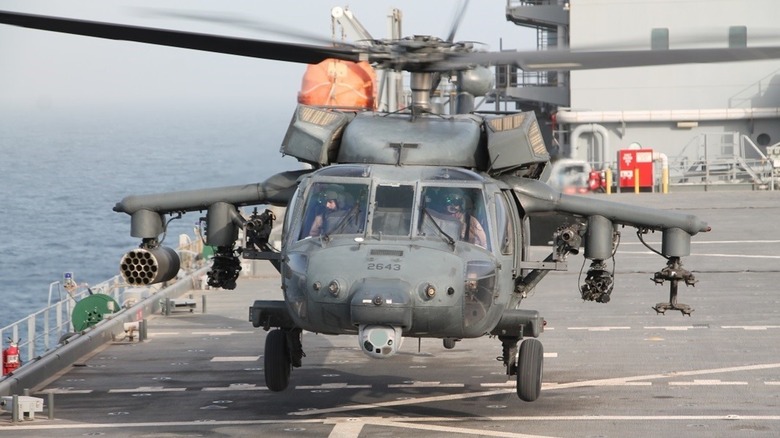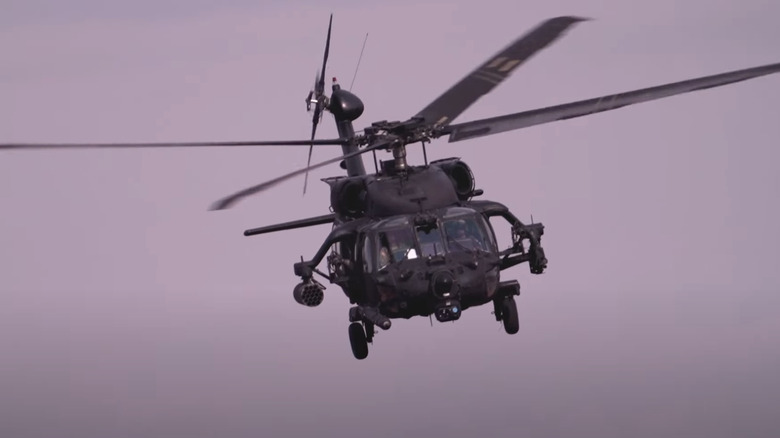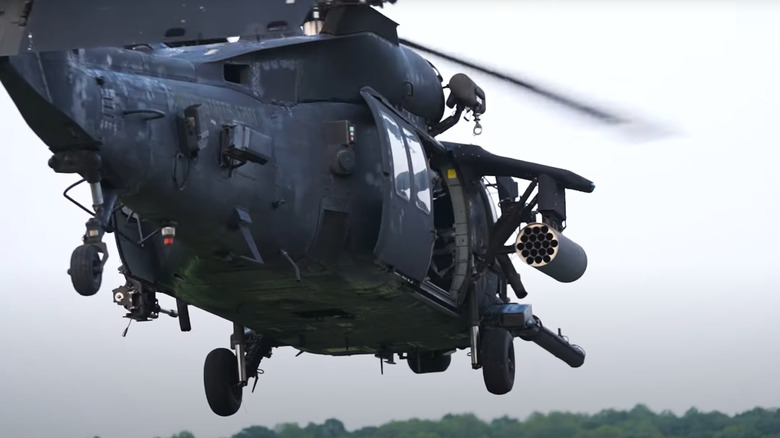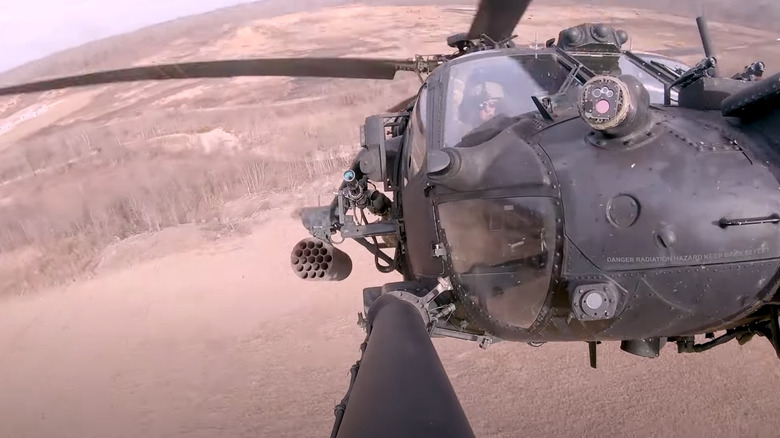This Lesser-Known Gunship Variant Of The MH-60 Black Hawk Is Packed With Extra Firepower
Since its introduction in 1979, the UH-60 Black Hawk has not only survived in the U.S. Army for 40 years — it has thrived. Its number one mission is to airlift personnel and cargo, but a baseline Black Hawk can be refitted to perform a wide range of specialized tasks.
Need to evacuate wounded soldiers from a battlefield under fire? Call in the HH-60, equipped with a rescue hoist, life support, and medical equipment for medical evacuation (MEDEVAC) missions. Or perhaps you need to discreetly insert special operators into sensitive areas of operation? The MH-60M variant has forward-looking infrared (FLIR) sensors to detect threats, laser designators, and in-flight refueling capabilities.Now, what if you require overwhelming firepower, the kind only a legendary AC-130 gunship or an Apache can deliver? The Black Hawk can help with that, too.
For this task, you'll want to get in touch with the Night Stalkers, the elite special operations pilots who fly the MH-60L Defensive Armed Penetrator (DAP). The DAP is what happens when military planners look at the UH-60 and ask: "How much firepower can we put in this thing?" Seating is removed to make room for ammunition reserves, and wing stubs with pylons are added to carry everything from extra guns to guided missiles and rocket pods. Here's what we know about this lesser-known MH-60 Black Hawk variant.
How much firepower can this MH-60 Black Hawk variant carry?
Armament-wise, the MH-60L DAP also carries door-mounted machine guns (typically M-134D miniguns). However, rather than be mounted on a swivel, they're fixed forward and are fired remotely by the pilots instead of by a door gunner. Sticking out either side of the fuselage are two stub wings, with an array of hardpoints hanging from them. Called the Light Armament Support Structure (LASS), they help the DAP bring an armory worth of guns and weapons with it.
The DAP can be configured with extra GAU-19 Gatling gun pods for laying down suppressive fire. To deal with more heavily armored targets, the DAP can be outfitted with M-230 chain guns — the same 30mm autocannon used by the Apache. It fires High Explosive Dual Purpose (HEDP) rounds that are capable of piercing through thick armor and also fragment when they strike the ground, blasting enemy personnel with lethal shrapnels (hence "Dual Purpose").
For explosives, the DAP can carry M-261 rocket pods compatible with Hydra 70 unguided rockets. It can carry guided missiles, too, like up to 16 AGM-114 Hellfire on M-299 launchers. Forward observers can guide these laser-guided anti-tank missiles precisely on target using laser designators, or the pilots can do it themselves using the helicopter's chin-mounted laser designator. And if airborne threats are present? A quad-packed rack of AIM-92 Stinger air-to-air missiles can make short work of them.
What missions does the DAP gunship go on?
All that firepower can be put to good use in fire support missions. While footage of the 160th SOAR in action is rare (it goes with the territory of being a component of the U.S Special Operations Command), a brief video offers a dramatic glimpse of the DAP laying down intense suppressive fire using its armament in a pretty terrifying show of force.
The U.S. Army Special Operations Command (USASOC) also utilizes the DAP's role as an armed escort. Basically, the armed chopper shadows ground convoys through high-risk areas and provides immediate fire support with their weapons if needed.
Last but not least, although the DAP isn't meant to carry troops (the helicopter is seriously packed to the brim with ammunition), that doesn't mean troop transport is completely out of the question. The USASOC notes that the DAP can also be used for "armed infiltration or exfiltration of small units." There's still space at the rear for a few operators, so the DAP can take aboard a handful of soldiers and either bring them to the fight or get them out like a conventional Black Hawk, too.
Why bother with making this MH-60 Black Hawk anyway?
When you think about it, the MH-60L DAP doesn't do anything that existing gunships in the U.S military's inventory are capable of doing. The Apache has many of the same weapons systems in terms of firepower, for example. So, why all the effort?
You see, the DAP is solely operated by the Army's elite 160th Special Operations Aviation Regiment (SOAR). The aviators in this unit — called Night Stalkers — are the best around. Their job is to support special operations forces like Navy SEALs and 1st SFOD-D (Delta Force) by bringing them in and out of combat zones, delivering supplies, or providing fire support. The unit go-to rides are special variants of rotary-wing aircraft like the CH-47 Chinook, the super fast and small MH-6 Little Bird helicopter, and the MH-60 Black Hawk.
Adding a completely new aircraft like the Apache to their inventory would require extensive retraining for all of their pilots. Instead of going through all that hassle, the Night Stalkers took the MH-60L Black Hawk they were already experts at flying and simply upgunned it. This way, SOAR can also ensure each unit is stacked with enough firepower for any mission thrown at them.



